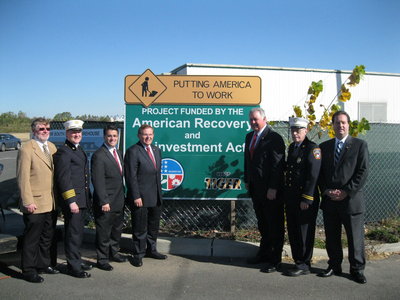With a stiff wind blowing off New York Harbor, public officials gathered in the Harbor Station section of the former Military Ocean Terminal in Bayonne to break ground on the construction of what will become perhaps one of the most advanced fire houses in the state, paid for by $3.56 million federal grant from the Assistance to Firefighters Fire Station Construction Grants program. It is one of $380 million in grants funded by the American Recovery and Reinvestment Act (ARRA) to pay for fire station construction, as well as port and transit security initiatives nationwide.
Bayonne is the only fire department in the state to receive this grant, and this is the sixth largest amount to be awarded to any municipality in the nation. The new firehouse is replacing the tent that the department currently uses to house fire vehicles servicing the Route 440 area.
As the host of officials, dressed in suits and ties, gathered on a platform near a single work trailer, men and women in hard hats carrying shovels or operating back hoes continued a process started early last summer when piles were driven to provide a foundation for the new home that will host two Bayonne fire companies and allow them to move out of the tent located only 50 yards away.
When the Peninsula was still in operation as a military base, the U.S. Army maintained its own fire department and built a firehouse there. When the federal government closed the base in 1999, Bayonne took over the fire service. But the sale of the land forced the fire department to relocate. This coincided with a report by Matrix Consultants in December 2007 that recommended combining several operating departments at one location.
The new fire house, said U.S. Senator Robert Menendez, replaces two houses that the department formerly operated out of, one built in 1888 and the other in 1939.
“This is another step at securing the area.” – Rep. Albio Sires
__________
Groundbreaking ceremony
As officials spoke about the bright future the new fire house promised, rubble from the site’s past stood near by, stones left over from when the site as served as the location for homes of military personnel. They were piled on a corner of the base that supplied the needs of military campaigns from World War II in the 1940s to Desert Storm in the early 1990s.
Ducks swam across the surface of a small pond that reflected the changing leaves on a few small trees while officials boasted of the new beginning and the promise of increase public safety that the new fire house would bring.
Rep. Albio Sires, along with Menendez, had made the case in Congress for the new fire house. He cited its proximity to New York and the threat posed to this stretch of harbor that the FBI once claimed as the two most dangerous miles in America, a section that includes the Holland Tunnel, Global Terminal cargo port, and chemical storage tanks.
Since the new fire house will also serve as a training facility and a decontamination center, and its fire fighters will respond to any threat along the Eastern side of Bayonne and beyond, the Congress agree, Sires said.
“This is another step at securing the area,” Sires said.
Dressed in a fire uniform rather than his usual robes, Father John Doherty called the new fire house “a house of protection” for the men and women who work in it as well as the residents of the City of Bayonne.
Fire Chief Greg Rogers, who oversaw the planning and construction of the temporary tent fire house, said he was also involved in the planning for the new station.
“The temporary fire house is not very accommodating,” Rogers stated, noting that in the tent and its trailers was a rotation of 12 to 16 firefighters every four days, all of whom had to live in cramped trailers and work in a moisture-filled tent.
“I look forward to the demise of the temporary facility and to the completion of the fire house that will replace it,” Rogers said.
Public Safety Director Jason O’Donnell said the state-of-the-art fire house is a reflection of the dedication of the people who will serve in it.
Menendez said that on Sept. 11, 2001, and during its aftermath, it was local government and first responders from the military base area that led the recovery effort.
“We called them heroes, and then many people walked away from them, their memory fading,” Menendez said. “But they have not faded from my memory, nor have the 700 from New Jersey who died in that attack.”
Menendez said firefighters need the resources and equipment to perform their duties, and the public needs dedicated and well equipped fire fighters to provide protection.
“This project creates 100 construction jobs and it creates conditions that allow these men and women to protect us,” Menendez said. “How do you honor men and whom who rush into danger when most people are going the other way? Many people thank them after a tragedy. But we should not wait for a tragedy to do the right thing. You first responders have our back and while I’m in the U.S. Senate, I’ll have your back, too.”
